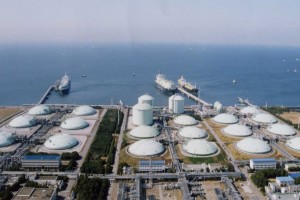 WTI and Brent futures traded lower during morning hours in Europe today. Yesterday the US reported a sizable decline in crude oil inventories, which, however, was not enough to push contracts into the positive, as the market is still quite oversupplied. Plenty of economic data was released this week, though key reports are still awaited.
WTI and Brent futures traded lower during morning hours in Europe today. Yesterday the US reported a sizable decline in crude oil inventories, which, however, was not enough to push contracts into the positive, as the market is still quite oversupplied. Plenty of economic data was released this week, though key reports are still awaited.
West Texas Intermediate futures for settlement in July traded for $102.40 per barrel at 7:11 GMT on the New York Mercantile Exchange, down 0.23%. Prices ranged from $102.19 to $102.47 per barrel. Yesterday WTI closed for a 0.02% loss, and so far for the week the contract has dropped 0.06%.
Meanwhile on the ICE in London, Brent futures due in July stood for a 0.14% drop at $108.25 per barrel at 7:11 GMT. Daily high and low stood at $108.35 and $108.00 per barrel, respectively. Brent’s premium to WTI stood at $5.85, largely on par with Wednesdays closing margin of $5.76. Yesterday the European brand closed for a 0.39% drop, and so far for the week the contract has lost 0.93%.
US oil supply
The weekly Energy Information Administration report on oil inventories in the US for the week ended May 30 was released today. Commercial crude oil stockpiles were revealed to have dropped 3.431 million barrels for a total of 389.5 million barrels in stock, after a 1.657 million barrel increase was logged for the week through May 23. Yesterday the private American Petroleum Institute (API) had suggested a 1.4 million barrel decline, while a Bloomberg survey projected 0.25 million more barrels.
“There’s still concern that the market is oversupplied,” said for Bloomberg Jonathan Barratt, chief investment officer at Ayers Alliance Securities in Sydney. “If oil can’t move higher on draws at the beginning of the drive-time season, then what will it move higher on?”
Inventories at Cushing, Oklahoma, the largest US storage hub, and the delivery point for the New York WTI contract were shown to have lost further 300 000 barrels and stood at 21.4 million, after the previous report logged a 1.5 million barrel drop. Meanwhile, hubs at the Gulf coast also logged losses, for a massive drop of 6 million barrels and are now at 207.1 million, after a 3.1 million gain last week.
Domestic production of crude oil stood at 8.383 million barrels per day (bpd) with a decline of 89 000 bpd, after a 38 000 bpd growth for the previous week. Meanwhile, imports of crude for the week were read at 7.123 million bpd for a massive 0.686 million bpd drop, after a further 0.658 million bpd drop last week.
Motor gasoline supplies increased by 210 000 barrels and now total 211.8 million barrels, after the EIA posted a 1.8 million barrel drop last week. API had suggest a 0.8 million increase in gasoline stockpiles. Stockpiled distillate fuels added 2.012 million barrels for a figure of 118.1 million, after an insignificant decline last week. Meanwhile, API had projected a 300 000 decrease for distillates inventories.
Refinery utilization rate was reported at 90.8%, which is an increase of 0.9%, after a further 1.2% increase last week. Gasoline production was logged at 9.476 million bpd, for a drop of 89 000 bpd, after a further 66 000 bpd drop last week. Meanwhile, gasoline imports were reported at 844 bpd, which is an of increase of 119 000 bpd, after a 272 00 fall last week. Distillates production averaged 5.227 million bpd, for a growth of 237 000 bpd, after a 91 000 growth last week. Distillates imports grew by 34 000 bpd to 182 00 bpd, after a 30 000 decline last week.
Demand outlook
Eurozone
Today the Eurozone, consuming about 14% of the worlds supply of oil, will reveal retail sales for April, and forecasts suggest an insignificant 0.1% growth on a monthly basis, after 0.3% for the previous month. More importantly, the ECB interest rate decision will be unveiled, and experts expect a decrease to 0.10%, down from 0.25%.
Yesterday the Bloc released reports on GDP growth and services PMI. GDP growth was as expected, at 0.2% on a quarterly basis, while the services sector expanded, but at a slower pace.
Previously, the Eurozone posted more disappointing CPI on Tuesday, reaffirming speculation that the European Central Bank (ECB) will indeed take steps to ease the deflationary pressure, as suggested by ECB President Mario Draghi in May.
Tomorrow more data is due. Early on, Germany will post seasonally adjusted industrial production for April, and experts forecast a standing of 0.4% growth, after a 0.5% contraction for March.
US
Later today, the US, which accounts for 21% of total oil consumption, will post the weekly jobless claims report. Analysts forecast a slight increase in initial applications for unemployment benefits for the week through May 31 to 310 000, from 300 000 for the previous week.
Tomorrow the US will post key employment figures. Unemployment rate for May is expected to stand at 6.4%, after 6.3% for April. Meanwhile, nonfarm payrolls for May have probably added only 219 000, after a 288 000 figure for the previous month, signaling the US is not quite out of troubles yet.
Yesterday ADP posted preliminary figures on payrolls in the US, which stood for 179 000 new payrolls in May, well below the downgraded April reading. Also, ISM revealed non manufacturing PMI for May to exceed expectations and pick up expansion rate by about 20%. The services sector accounts for about 80% of US GDP.
China
Early today, HSBC posted its reading on services PMI for May in China, which consumes about 11% of all oil. The figure, which measures private sector services growth, was logged at 50.7, after 51.4 for April. A reading above 50 means expansion, while anything below is read for contraction, and the greater the figure is from 50, the bigger the expansion or contraction is.
Previously, HSBC reported contracting factory activities in China, while the official governments reports revealed an expanding manufacturing sector and a significantly growing services sector, conflicting with HSBCs readings (Do note the governments services gauge includes non private companies).
On Saturday China will report exports, imports and trade balance, with expectations of sizable growths both ways, after muted expansion were reported last month.
Technical view
According to Binary Tribune’s daily analysis, in case the West Texas Intermediate July future on the NYMEX breaches the first resistance level at $103.44, it probably will continue up to test $104.24. Should the second key resistance be broken, the US benchmark will most likely attempt to advance to $104.79.
If the contract manages to breach the first key support at $102.09, it will probably continue to drop and test $101.54. With this second key support broken, the movement to the downside will probably continue to $100.74.
Meanwhile, July Brent on the ICE will see its first resistance level at $109.24. If breached, it will probably rise and probe $110.09. In case the second key resistance is broken, the European crude benchmark will probably attempt to advance to $110.67.
If Brent manages to penetrate the first key support at $107.81, it will likely continue down to test $107.23. With the second support broken, downside movement may extend to $106.38 per barrel.





